Most people know breastfeeding is one of the best ways to help a baby thrive. And now it seems a mother's milk has beneficial effects even when her child reaches adulthood.
New University of Toronto research has found that if people genetically at risk of becoming obese are exclusively breastfed as a baby it can help ward off weight gain when they're young adults.
The study is part of a growing body of evidence about the benefits of breastfeeding – yet the World Health Organisation says nearly two out of three infants aren't exclusively breastfed for the recommended six months – a rate that hasn't improved in 20 years.
When asked, 80 per cent of the women who stopped breastfeeding before six months said they would have liked to continue for longer, but often lacked support and guidance.
"Our society is letting mothers down – there needs to be much more investment in breastfeeding support and education," says NCT breastfeeding counsellor Cordelia Uys, a breastfeeding expert for the holistic new mums' wellness app Biamother (biamother.com).
"Breastfeeding confers numerous health protections on both mother and child and creates a strong sense of emotional connection. In addition, for a mother to see her baby growing and thriving on her milk can be one of the most satisfying and rewarding experiences of her life."
Here, Uys outlines ten surprising breastfeeding facts...
1. Breast milk is personalised medicine
There are numerous antiviral and antibacterial properties in breast milk that protect a baby from infection. These infection-fighting properties are being continually updated in response to the mother and baby's environment. When a mother's body encounters a new germ, her mature immune system will deploy millions of white blood cells to fight it off and quickly pass them on to her baby via her milk.
2. Breast milk contains stem cells
Every time a mother breastfeeds her baby, stem cells in her breast milk cross the baby's gut and into their blood, and then travel to all the baby's organs, including their brain. These stem cells are capable of becoming functioning cells all over the infant's body. It's believed they can boost and support the infant's optimal development and protect them against infectious diseases.

3. Breastfeeding has to be learned
Many people think breastfeeding will come naturally to mothers, but in fact, for all female apes, breastfeeding is a learned behaviour. A juvenile female gorilla in Ohio Zoo, having been separated from her mother at a young age, had no idea how to feed her first baby. But during her second pregnancy, zookeepers had the inspired idea of asking human mothers to regularly breastfeed their babies in front of her. When her second baby was born, the gorilla immediately picked it up and put it to the breast.
In the past, human mothers would have learned how to breastfeed by watching relatives and friends. For this reason, it's a good idea for pregnant women who want to breastfeed, to spend some time with a friend who's successfully nursing her baby. The National Breastfeeding Helpline and apps can also offer advice on breastfeeding.
4. Over 95 per cent of women can produce all the milk their baby needs
The vast majority of women can make all the milk their baby needs and, contrary to popular belief, the size of a woman's breasts doesn't impact the volume of milk she can produce.
Milk production depends entirely on supply and demand: in the early months, milk needs to be removed effectively from both her breasts at least eight times in 24 hours for a mother's supply to be established and maintained. By far the most common reason for low milk supply is under-stimulation of a mother's breasts, either because her baby isn't feeding frequently enough or isn't removing milk effectively.
5. Breastfeeding acts as a natural painkiller
Breast milk contains natural painkillers called endocannabinoids. Breastfeeding before and during vaccination injections has been shown to reduce pain in babies.
6. Breastfeeding protects mothers against breast cancer
The Tanka Fisherwomen of Southern China traditionally only breastfeed their babies from their right breast. In the early 1970s, a medical student at a Hong Kong clinic noticed that if Tanka women developed breast cancer, in 79 per cent of cases, it was in their left breast. It was this observation that led to the discovery that breastfeeding is protective against breast cancer.

7. Breastfeeding shouldn't hurt
Pain is there to tell us something is wrong, and this is true for breastfeeding too. Pain and damage happen when a mother's nipple isn't positioned correctly in her baby's mouth. In the majority of cases, when a baby is well-positioning and deeply latched, breastfeeding will be completely comfortable. If breastfeeding hurts, it's important to seek out qualified support as soon as possible.
8. The temperature of a mother's breasts adapts to her baby's needs
A mother's breasts can warm up by 2C if the baby is too cold, and cool down by 2C if the baby is too hot. In fact, it has been shown that when newborn twins are placed in skin-to-skin contact with their mother, each of her breasts will heat up to a different temperature according to each baby's needs. This is called thermal synchrony.
9. Breastfeeding mothers get more sleep
Studies have shown breastfeeding mothers sleep on average 45 minutes more a night than mothers who formula feed. Human milk contains substances that promote sleep and calmness in babies. Mothers release the hormone prolactin into their own blood while breastfeeding, which helps them to fall asleep more easily.
10. Breastfeeding is carbon neutral
When a mother is breastfeeding, there is zero waste and no carbon emissions. Research at Imperial College London has shown breastfeeding for six months saves an estimated 95-153kg CO2 equivalent per baby compared with formula feeding.
:: National Breastfeeding Helpline (nationalbreastfeedinghelpline.org.uk): 0300 100 0212








